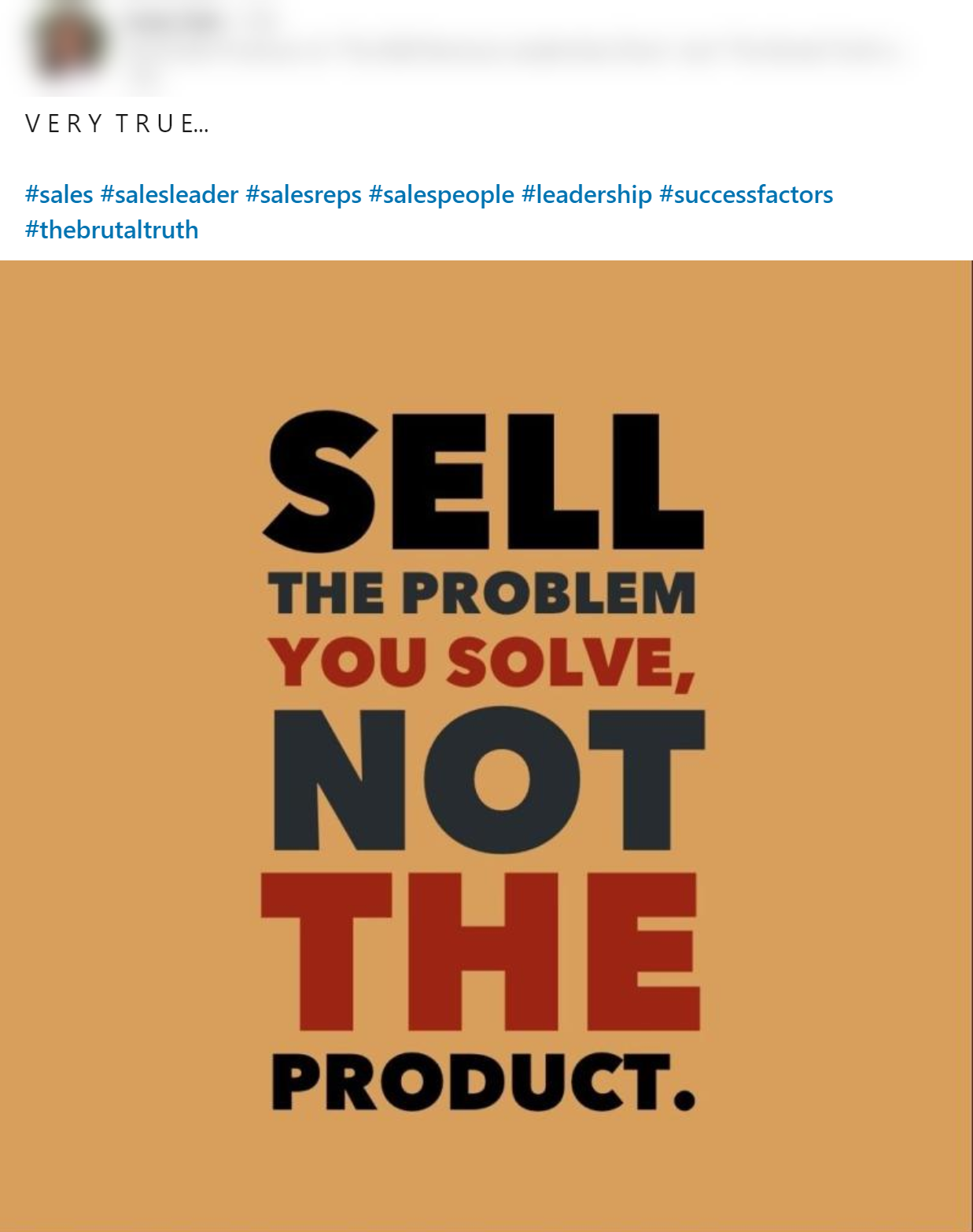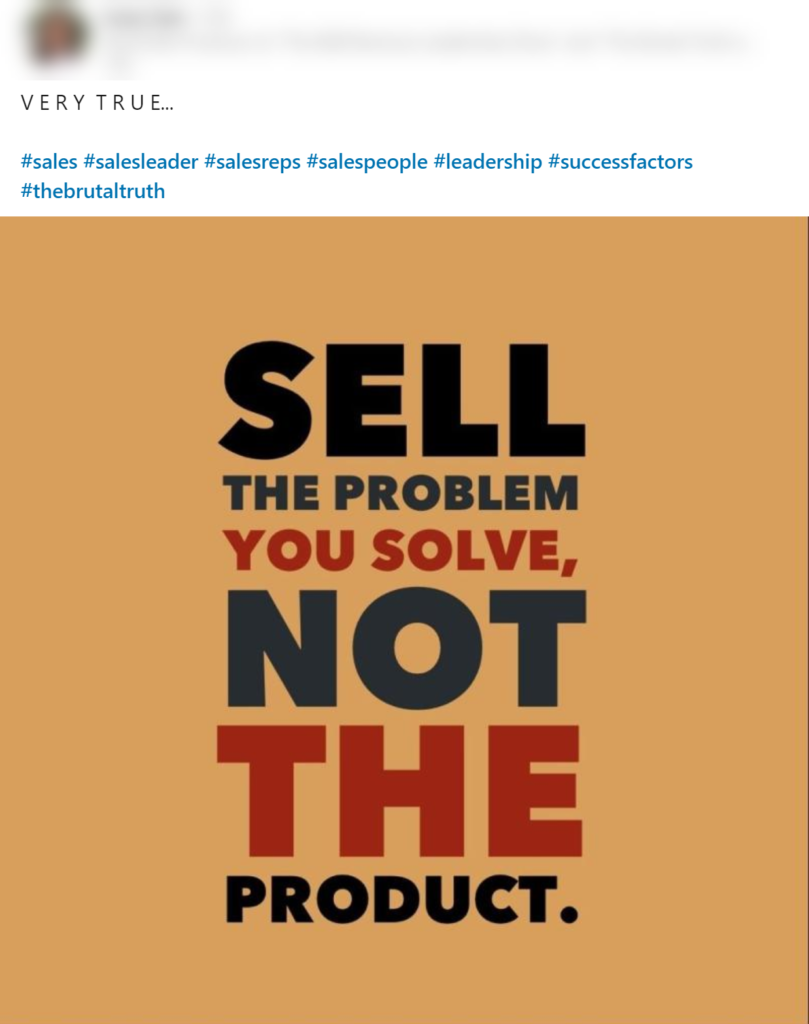You know it because you've seen it.
You know it because you've heard it.
What (pray tell) am I talking about?
Generic sales and marketing advice.
It's danger is insidious.
Why? Because it sounds bang on.
Thing is...
Generic advice is either lacking or flat out bad advice.
Take this advice I keep seeing on social media:

On the surface, it seems right.
The Rationale
- People don't buy my stuff unless they have a problem to address.
- If I sell the problem, I get my audience to feel the pain my stuff alleviates.
- If I get them to feel the pain, they have a real reason to buy my stuff.
On the surface it makes logical sense. But, it's not that clean anymore. The way people consider a purchase of ANYTHING has changed.
In reality, it does damage.
The Reality
- People buy to address a problem.
- They've become weary of sales and marketing approaches that seem designed to stoke fear or otherwise get them off their own status quo.
- With so many people "selling the problem" in a way that lacks context and nuance, buyers see through the approach quickly.
When you "sell the problem" without a deeper understanding of your audience, a deeper understanding of the problem your offering addresses, and--most importantly--where your audience is toward addressing that problem, you are more likely to come across as salesy and manipulative.
And when that happens you most definitely do NOT sell more stuff.
So what can you do about it?
Here are three steps to create a better problem message.
1.) Understand the buyer journey.
The buyer journey is the path your audience takes to make a purchase. And, while it can be different for different types of offerings, at a high level every buyer journey looks the same.
Before someone buys anything, they have a need or a desire to make a change.
- This change can be because of a broad market shift. (eg., how people buy has changed.)
- This change can be because of a market problem (eg., I don't attract buyers like I thought I would.)
- This change can be because of a desire. (I want to attract more buyers.)
To further illustrate that this can be for ANYTHING, consider a pack of gum.
When you buy a pack of gum, what's the change you want to make?
"There is no change, dude! I just want a pack of gum!!"
Ah...but there IS a change. We only have to identify it...
- Is there a broad market shift in play? (No. I just want some gum!)
- Is there a market problem to address? (No. I just want some gum, dude!)
- Is there a desire for gum? (YES! I want some gum, dag-nabbit!!)
The change you face when considering a gum purchase is not what you might consider change...but as soon as you buy that gum, you've changed the situation.
I really wanted some gum, but I didn't have any. I bought a pack. Now I have some.
With this context in mind, take a look at the Buyer Journey:
The question to ask yourself before you take generic messaging advice—you know, like "sell the problem"—is "Where is my audience on their path to purchase?"
If your audience is already engaged and seems likely to be considering their options, a Why Us message (i.e. reasons to consider my product/service/solution) is more appropriate than a Why Change (i.e., feelings brought about by a change, problem, or desire) one.
In other words, If I already recognize I have a change I want or need to make, selling the problem—at best—aggravates me. You're not providing me anything that helps me make a decision. You're telling me what I already know. That's annoying.
"Ah! But, Zach!! Sell the problem is advice for the unaware buyer! You sell the problem when your audience isn't aware of it...or you!!"
It's true that an unaware buyer is a more appropriate target for "sell the problem." But, "sell the problem" is still terrible advice, even for this audience segment.
Why?
How you view the problem may not be how your audience views the problem.
And so, dive in on the next step:
2.) Uncover context.
Selling the problem used to work.
Back before the event that changed us all, you could sell the problem all day long without any fear of blowback.
But today? Buyers are a whole lot more savvy to your plans.
Get too aggressive selling the problem, and you'll learn—FAST—just how deep-seated your audience's hatred of salesy approaches is.
Context matters.
Without context—that is, a connection back to your audience's specific situation or mindset—selling the problem at best is noise. At worst, it comes across as a desperate attempt to stoke fear.
Neither is a good way to attract a buyer.
So how do you reveal context? Ask yourself some questions:
- Why is [FILL IN THE PROBLEM HERE] such a problem?
- What are the effects of [FILL IN THE PROBLEM HERE]?
- How do these effects make my audience feel?
- How does my audience currently address [FILL IN THE PROBLEM HERE]?
- How does my audience act before they're full aware of [FILL IN THE PROBLEM HERE]? Are there common actions they take? Feelings they feel? Something else?
- What would addressing [FILL IN THE PROBLEM HERE] mean for my audience?
Earnestly (and honestly) answer these questions, and you'll be on a better track to create a Why Change message that resonates.
Once you have a good bead on context, it's time to get specific.
3.) Find the nuances of your audience's lingo.
I've said this many times before:
What you say and how you say it may be the most important thing in business.
Nuance is the how you say it.
It's taking what you want to say and making it more familiar.
Without nuance—that is, subtle words and phrases used or otherwise recognized by your audience—selling the problem can come across as inauthentic, leading to that feeling that you're just here to sell me something.
Nuance is specificity for your audience.
Nuance is at play in how people in different audience segments talk about things. This is true in more traditional segments: industry, geography, role or title, etc. AND, it's true in less traditional segments (like attributes) that could define your audience: frugal, self-confident, visionary, conservative, etc.
For example, let's say you're selling healthcare tech that helps doctors predict complications before they happen.
To the general public, you could talk about the dangers of complications in healthcare. You could talk about the effect that unexpected complications have and what that means to patient populations. You could even talk about how medical practitioners have too much information these days to be able to make anything of it, let alone better treat their patients.
But none of that gets things exactly right for your intended audience. There has to be more.
And there is.
Interact regularly with your audience, and you learn how to articulate things the way they do.
For example, I literally just got off a quick call with a medical professional who's been practicing for more than 20 years. And after that 5-minute, 22 second conversation, I was able to turn the above into this:
When you log into the EHR*, what do you see? It's the past. It's all retrospective...it's literally impossible for it to be in the moment.
That mean if you rely on your EHR, you provide reactive care as a rule.
When you have 200 patients to worry about, how do you have the time to worry about them all equally, let alone react when one experiences an unexpected complication?
The way things are, it's just not possible to know who's at the most risk
What could moving from reactive to proactive care delivery mean for your patients and the care you provide them?
See the difference?
I'd never speak to a broad audience about moving from reactive to proactive care. I'd certainly leave out the reference to the EHR (*electronic health record).
Likewise, if I approach the medical audience with a generic problem message, I'm a gnat. I willingly show off that I don't deserve a conversation, let alone "30-minutes for a demo."
Selling the problem can be good advice.
But, it's not that simple.
When you make it that simple, you whiff on opportunities...and worse...you do damage to your brand.
#BOOMshockalocka
🤘👊💥😎
Yo! Awesome person who got to the bottom of the page!!
Did you learn something from this?
Did you find it a worthwhile read?
Drop a comment below!
Or share it! Here are some links:
